In recent years, we have seen a rise in regenerative agriculture events, culminating in a busy summer calendar for our technical experts, who have met grassland farmers with differing systems and facing production challenges.
Reflecting on those experiences, we want to discuss which principles of regenerative agriculture can benefit UK grassland farmers and how they can be implemented.
Every farmer is on a different journey presented with unique challenges, so if each farmer can take just a couple of steps towards being more sustainable, it can benefit us all.
1. Minimising soil disturbance
Different reseeding methods are available to grassland farmers, with each having pros and cons. While ploughing achieves good seed-to-soil contact, it causes soil disturbance that releases carbon from the soil when we’re trying to reduce emissions.
Ploughing can also disturb dormant seedbanks of weeds that can disrupt reseeded leys, decreasing productivity and requiring a chemical solution. Fortunately, there are two alternatives for reseeding grassland without ploughing:
- Minimum tillage: With min-till, you minimise soil disturbance while still ensuring good seed-to-soil contact. This method works well on stony, shallow soils Min-till can be done with an air drill, disc drill or slot seeder.
- Direct drilling: Soil will only be disturbed when seed is drilled into the ground. Direct drilling can work well if you remove the trash and spread lime to neutralise surface acidity.
2. Soil cover offers protection
We understand that healthy soil is needed for growing nutritious grass and forage for livestock. When soil is uncovered, it’s exposed to the elements, with extreme weather conditions causing major damage to soil structure and depleting nutrients.
Now, let’s explore the available options to ensure soils remain covered. Grass-clover and multi-species swards are both effective, though you can also utilise cover crops if you need to prevent soil erosion in an arable rotation. Options include hybrid brassica, kale, swede or turnips, with soil organic matter improving over time from returning crop residues.

3. Maintain living roots
By maintaining living roots, farmers can increase carbon capture in soil, improve water filtration and improve soil integrity. Living roots also provide a feed source for creatures that feed on bacteria and fungi to support soil health. When mycorrhizal fungi thrive, they can nourish crops by acting as a natural fertiliser.
4. Forage diversity
By reseeding with grass and clover, farmers can develop a natural source of nitrogen that will reduce inputs. Or you can go further by establishing diverse multi-species swards. The combination of different species can provide livestock with a more balanced source of nutritional forage, offering protein, energy, minerals and other trace elements.

The high digestibility of multi-species swards can drive matter intake and there’s greater weight gain in finished livestock. Some farmers are even finding that the herbs offer anthelmintic properties to control parasites.
Multi-species swards include legumes to ensure nitrogen fixation. Soil health is further supported by longer-rooting species that are better at withstanding prolonged dry spells and can improve soil structure. These swards are also denser and better at resisting poaching, which is extremely damaging to soil. Multi-species also support greater biodiversity by attracting insects and pollinators.
Better soil health yields higher production
By using regenerative farming methods to improve soil health, UK grassland farmers can grow better, more nutritious grass and forage with fewer chemical inputs while reducing emissions.
With agricultural emissions firmly on the government agenda, it makes sense to be proactive and integrate sustainable methods that can be productive in grassland farming systems. Contact our grass and forage experts to make this happen on your farm.
